Santorini one of the top 5 destinations in the world!
Who does’nt know this island, the magical black pearl of the Aegean sea…the famous volcanic island of Greece?
Ideal for honeymooners and couples, for photographers, for wine tasting, for a wedding destination….for everything!
In a short glance we will share the Ten moments from the story of Santorini.
Everybody knows the name; people talk of her far and wide, dream of her in one way or another, they wish they could enjoy one sunset at Caldera. Santorini has a lot to tell us. Let’s listen to her…
- Myth wants Santorini emerging from the depths of the seas with the name Strongile (translating as “the round one”) in account to her shape. A prehistoric city, boasting a great port is founded at Acrotiri, on the third millennium BC. After many days of growth, an earthquake at the ends of the 17th century BC levels the cosmopolitan city. The masterpieces (murals) of the new city that was built on the ruins of the older one are those we admire today at the Museum of Prehistoric Thira.
- The catastrophic eruption of the island’s volcano during the Late Bronze Age (circa 1600 BC) buries anything grand that existed on the island. What remains are three expanses of land -now three separate islands- of great geologic interest (the largest of the three with Caldera, Nea Kameni, and Thirasia), the likes of which are not found in any other part of the world!
- At the ends of the 13th century BC, the island is inhabited by Phoenicians and, after them, Spartans (8th century BC), who were the ones that renamed the island Thira. During that period the island didn’t develop culturally other than the founding of a colony, Cyrene, and, during the 8th century BC, the adoption of the Phoenician alphabet alongside Crete and Milos.
- The Ptolemies used Thira, during the Hellenistic period, as a strategic base, while, during the roman era, the island disappears from the maps.
- During the Byzantine era (the entire population of the island had espoused Christianity during the 4th century AD), the church of Panagia Episkopis Gonias was founded on the island by the Emperor Alexio I Comneno (11th century AD), that still stands at Mesa Gonia.
- After the Crusades the island was granted to Marco Sanoudo (1204) and was included to the Aegean Dukedom. The Venetians were the ones that renamed the island Santorini, paraphrasing the name Santa Irini. The competition between the Latin conquers and piracy infest the island of Santorini.
- During the era of the Turkish conquest (1579-1821) the island develops commercial activities and formed contacts with the ports of the East Mediterranean. Economic and political progress followed, that accelerated after the treaty of Küçük Kaynarca Antlaşması (1774), when the ships from Santorini were allowed to fly the Russian flag and sail the Mediterranean. The annexation of Santorini to the fledgling Greek republic in 1830 signaled a new era of great commercial and maritime prime, while the local production (tomatoes, wine and textile industry) took off.
- The 20th century was a time of decline for Santorini due to the world wars. The destructive earthquake of 1956 desolated the island.
- Tourist development, that started in the late seventies, brought the island back to the center of the global attention, where it has always belonged.
The Sunset

When one arrives in the island of Santorini there are two feelings that usually interfere to the excitement of the moment. The breathtaking view of the caldera and the volcano and the darkness of the sol, the “black pearl of Aegean”!
The magic starts when you close your eyes, feel the air and let yourself free to be seduced from the stunning moment of the sunset. Sunset colors all over the caldera surrounded by blue waters and dark rocks…one of the most amazing sunsets in the world. Is it the contrast of the colors, the position of the sun, the historic air that blows around, or is it just a fairy that plays with the mind?
For the avid photographers, there is no place like Santorini. It could be the Mecca of outdoor photography. Many acclaimed photographers from all over the world have shot amazing photographs, particularly depicting the ethereal Santorini sunset. A novel way of experiencing the sunset of Santorini is by embarking on a sunset cruise on board on a traditional sailing boat. Experience the magic of this island which was reborn from its ashes, stronger, more stunning and really unique- thus confirmed the story of the Phoenix.
The Villages of Santorini
The Cycladic island of Santorini is not only famous for its history, its volcano and the caldera, but also for its beautiful traditional villages. Villages with traditional dome housings in white and blue, surrounded with beautiful colorful flowers.
There are still some villages that remain untouched by the touristic development and what they have in common is the fact that there is not any road crossing the village and the car access is restricted. All of the villages offer a view into the traditional architecture of Santorini in the past, surrounded with lots of small pitoresque churches.
Oia
Oia’s village otherwise pronounced Ia is at the northwest approximately 11 km from Fira. Oia is famous for its amazing view, the unique colorful sunset, the pitoresque traditional housing with the small alleys, the ruins of the Venetian castle (15th century) and its lovely harbor Ammoudi where one can enjoy nice seafood plates.
Imerovigli
Imerovigli is one of the quietest villages with caldera view. Is located 3 km North West of Fira and looks like an extension of Fira and Firostefani, but is on a higher cliff and is recognized form the strange pop rock Skaros. At the years 1200-1500 the Venetians established a feudal system in Santorini and built fortified castle settlements one of which is Skaros in Imerovigli. Skaros was chosen as an ideal settlement mainly because it was in a very high position, and there was good visibility for identifying and alerting for any pirates attacks.
Firostefani
Firostefani the pitoresque village with the stunning view and its lovely small restaurants. It is located 2 km north of Fira and is supposed to be like a suburb to the capital of Santorini. One should not miss taking the beautiful walk from the caldera paths either to Fira or to Imerovigli and reach Skaros and the small Prophet Elias.
Fira
Fira is the capital of Santorini and the main transport hub of the island. Although it gets very busy in summer, it still offers some of the greatest view to the volcano and the famous caldera of Santorini. Fira is almost at the center of the island and serves for easier access and transportation to the rest of the island. In Fira is also worth visiting the Cathedral church, the museums, the exhibition centers, art galleries, and experience different cuisines and tastes (Aegean, Mediterranean, Italian, Mexican, Indian, Chinese, and Thai etc.)
Pyrgos
Pyrgos village is built on the slopes of a hill and was until the early 1800, the capital of the island. The pitoresque village with the best view in the island offers a panoramic view of the whole island. It is composed of traditional houses built around the Venetian Castle and the small paths follow the shape of the hill. Pyrgos is a beautiful, traditional village with remarkable tourism development the last decade. The village has around 33 churches, but the most famous is the Monastery of Profitis Ilias, where a small collection of ethnographic material and old icons are exhibited.
Messaria
Messaria village is situated in the middle of the island. The old village of Messaria has a Cycladic charm with an outstanding architecture, surrounded by gardens and vineyards. One of the most impressive sites in the village is the Argiros mansion, built in 1888 by winemaker George E. Argiros. It is worth visiting the churches of Metamorphosis of Sotiros, the Metropolis church and Saint Irini, built around the 1700.
Vothonas
Vothonas is a small pitoresque rocky village with a strange architecture. Leading off it, a tangle of paths climb up to the houses, a complex of network of open and closed excavations, a unique and untouched architectural complex and ruins of old housing and churches. Another interesting place to visit is the church of St. Anna which is the oldest in the village and it was built in 1827. The most interesting of all is the church carved in the rock, named Panagia Sergena. The Church of Panagia Sergena was a shelter for the locals during pirate invasions. The church was dug in the rock 20 meters above the ground and hidden from site. One will have to follow the hidden path that leads to Panagia Sergena and walk about 10 minutes.
Exo Gonia & Mesa Gonia
Exo Gonia is a small village built at the slopes of Mesa Vouno (Prophet Ilias Mountain) and offers the best spot for admiring the sunrise. The traditional farming village is quiet, with nice view towards the sea and the flat land where the airport lies. One of the best view spot is at the church of Agios Charalambos where you can see the entire island.
Episkopi Gonia can be found at the foothills of Profitis Ilias Mountain on the way to Kamari. The village is also known as Mesa Gonia, since that was its official name until 1915. Mesa Gonia used to be in important area for producing wines. Episkopi Gonia received its name due to the proximity of the Byzantine church Koimisis of Theotokou, also known as Panagia Episkopi. History records that the church was the headquarters of both the orthodox and later the Latin bishop on the island. In Panagia Episkopi is exhibited the miraculous image of Mary a gift of the emperor Alexios Komninos to the church in the 11th century. The villages of Exo & Mesa Gonia used to have many inhabitants, but a big part of the villages destroyed during the earthquake of 1956 and most of the inhabitants moved to the newly built village of Kamari.
Kamari
Kamari is a coastal village on the southeastern part of the island which was completely rebuilt after the 1956 earthquake and was the most important strategic point on the island at the Ancient Thira times, at the 9th century B.C. Kamari, is now a tourist hotspot famous for its beautiful beach extends all the way to Monolithos and for its green landscape. It is a busy village with many beach bars, restaurants, night life, a football court and open air cinema where every year the Jazz Festival takes place.
Megalochori
Megalochori is one of the most pitoresque villages on the island together with Oia and Pyrgos. Its existence is recorded back to the 17th century. In the center of the village, there a wonderful traditional square with a great temple and steeple, taverns, restaurants and trees providing shade for a quick cup of coffee. Megalochori offers historical mansions, old traditional houses, pirate hideaways and wine canavas. Megalochori is the center of the wine industry of Santorini and it is surrounded by vine yards. The village has a history of merchants and wealthy land barons exporting Asyrtiko white wine and Vinsanto wine that the island still produces. A prominent feature of the historical houses is the high walls, inner courtyards and the wooden door entrances, built for privacy and for safety against the pirates.

Akrotiri
There is nothing more important to visit in the island. In short words, it is the first inhabited settlement on the island, one of the most important cultural coffins which dates before 4500 B.C. The prehistoric town that was buried from dust after the explosion of the volcano around 1600 B.C. The regular excavations in the early 1960 brought up the city of Acropolis (200 acres big). A fortified Venetian Medieval castle of the 13th century is also standing at the earlier village, but the remains of the castle are easily visible. There are two old churches in the village, Aghia Triada and Ipapandi tou Sotiros. Akrotiri offers fascinating view of the Caldera with picturesque atmosphere by the view towards Fira and Oia. Equally impressive is the street that leads to the Lighthouse Faros (the other end of the island), where one can be amazed by the caldera view at sunset hours.
Emporio
Emporio otherwise called Nimporios is the biggest village built in the South part of Santorini and has the biggest population on the island approximately 2.000 inhabitants. The old village part is built with small picturesque streets with historical houses in high walls, inner courtyards and wooden door entrances, built for privacy and for safety against the pirates. Emporio also has one of the 5 fortified castles “Castelli” built at the medieval years by the Venetians, vestiges of which are still visible. At the North side there is a square building named Goulas, in which the village people protected themselves from the pirates. It is also worth seeing one of the oldest churches on the island, Palia Panagia which is famous for the ornately carved wooden dome on its bell-tower and the ruins of the abandoned village (early 1980).
Prophet Elias
Prophet Elias is the oldest monastery in Santorini and is located at the highest edge of the island 567 meters high between Kamari and Pyrgos. The Monastery was built in 1711, and the walls round the Monastery remind of an old fortress. The history of Prophet Elias changes during the centuries. In earlier times, the Monastery was an active intellectual and patriotic influence, a wealthy monastery which owned its’ own ship that conducted private business for the benefit of the monastery and the island. From 1806 to 1845 it ran as a school where the Greek language and literature were taught. The monastery’s decline began in 1860, and most of its buildings suffered serious damage from the earthquakes during the year 1956.
Today the monastery owns an important collection of icons and bibles, and artifacts of the Greek Orthodox religion, ecclesiastical objects, books and ethnographic material, items dated from the 17th and 18th century. It also hosts a wine making area and typical local food.
ANCIENT THIRA
Ancient Thira was inhabited from the 9th century B.C until the 726. It is located in 360 meters high in Mesavouno Mountain between Kamari and Perissa. Ancient Thira took its name from the mythical Doric ruler of the island Thiras. The Spartan ruler Thiras and his fleet recognized the strategic value of this rocky ridge and developed an important settlement at the Southern periphery of Cyclades. The 3rd century B.C the city passes on the Ptolemaic. Then the city was completely rebuilt for the officer and the soldiers. In 145 B.C the Ptolemaic fleet was withdrawn and the Romans entered the city. The 3rd century we have the dissolution of the Roman Empire and up to the 5th century it was the only urban settlement on the island. The descriptions of the city primarily relates to the Hellenistic Golden Age.
Ancient Thira is a historical settlement that one should visit when traveling to Santorini. It is worth seeing many interesting sacred areas, churches, temples, buildings, theatre etc
MUSEUMS OF SANTORINI
The historical value of “Stroggyli”, which was renamed to “Thira” and nowadays is most popular as Santorini, gradually began to exhibit many of its important items to several museums and exhibition centers.
It is interesting to visit the Archeological museum in Fira, the museum of the Prehistoric Thira in Fira, the museum of Fossils and Minerals in Perissa, the Naval Maritime museum in Oia, Lignos Folklore museum in Kontochori, George Argyros museum in Messaria, the Kastelli area and Prophet Elias in Pyrgos. Do not miss the Archeological places of Akrotiri and Ancient Thira. As well, remember to visit the Megaro Gyzi Cultural Center, the Icons & Relics Collection in Pyrgos, the Wine museum in Vothonas, the Traditional Village of the “the Vanishing Village” in Pyrgos, the museum of Historical Instruments in Oia and “La Ponta” Bagpipe exhibition Center in Akrotiri.

WINERIES
Santorini is the ideal place for wine lovers too. Its volcanic soil and high daytime temperatures and humidity at night are ideal for creating a strong red wine which is very well-respected all around the world. The ideal climate encouraged the islanders to produce 36 different kinds of grapes (white and red) and leading to excellent wine producing.
The most famous types of wine are Asyrtiko, Nychteri and Visanto. Either type is made from white grapes. “Asyrtiko” is a very good quality wine that has the ability to be served even a decade after its production. “Nychteri” too is a very good quality wine, has a slight stronger taste and its specificity is that the grapes were clicked at night time. “Visanto” is the popular wine of Santorini. Although looks like a red wine, it becomes from white grapes which are dried under the sun for a couple of days. The strange thing is that Visanto when opened can keep its freshness in the fridge for months.

BEACHES
The volcano has not only created the unique caldera but also a coastline of unique impeccable beauty that only with a rare piece of art could be compared. Black, Red, White beaches all of different character, small and large, cosmopolitan and quiet, however all with a common denominator a picturesque of wild and unusual beauty.
Perivolos
First and by far the most organized in terms of entertainment and lifestyle, is the beach of Perivolos. An all welcome and well-organized beach with umbrellas and sun beds throughout its length, availability of water sports activities and beach bars offering refreshing cocktails and dancing, this is probably considered the most popular beach on the island. All places at Perivolos beach offer a great choice of food and fun. In this way, visitors can spend all day at the beach from morning until late evening in one of the busiest Bars of the area. One can access by motorbike/ car or bus.
Perissa
Perissa is also a very well organized and all welcome beach – It is essentially the continuation of Perivolos. It is a quiet beach, more family gathering, one of the first beaches developed on the island and it stays as one of the top choices among visitors. One can access by motorbike/ car or bus.
Vlychada
In the south of the island we find two beautiful beaches on the coast of Vlychada. At the left hand side beach the picture speaks for itself! Huge white rocks carved by the winds of the Aegean Sea. The black sand and pebbles form a thick lunar landscape that rarely does one meet elsewhere on earth. If one walks further the beach side, will realize that is an identical spot for gay couples. The right hand side beach called “Theros” looks really awesome and extraordinary. It is a rocky beach quite large in size, with beach sports and with a wonderful beach bar that offers tasty cocktails with sunset sea view. “Theros” beach is an all welcome organised beach with beautiful surrounding, but a little rocky inside. One can access by motorbike or car.
The Red Beach
Within walking distance from the archaeological site of the famous Akrotiri the visitor can find The Red Beach. Its name betrays its color. The volcano has given this color option in deep red rock and sand combination. Access is by foot, after a short climb and descent. During the summer months you can have access by boat from Akrotiri. Red beach is a well organised beach, which is considered to be one of the most touristic beaches of the island. It is worthwhile to admire this wonder of nature that will compensate you. A volcanic palette with dark red and deep blue colors! One can access by motorbike/car, or bus.
Kambia
Kambia beach Santorini is located on your way to Faros in the south west part of the island. It is not an organised beach, but offers natural scenery with black pebbles surrounded with volcanic rocks. One can also visit the traditional small Greek tavern and taste several sea food dishes. One can access by motorbike or car.
White Beach
White beach is located between the Red beach and Kambia beach. It is a stunning white beach, the only one might find in the island, which can be reached only by boat. One can visit the white beach by taking a tour boat from Vlychada port.
Mesa Pigadia
Mesa Pigadia Santorini is a beautiful small rocky beach with stunning surrounding of rocks and caves, white sand cliffs and deep blue waters. The beach is located approximately 1 klm before reaching the Light house “Faros”. One can access by motorbike or car.
Akrotiri Caldera Beach
Caldera beach is located a couple of meters before entering the village of Akrotiri at the south west part gazing the beautiful scenery of the caldera and the volcano. It is a large organised pebble beach, one of the few accessible caldera view beaches in the island. One can access by motorbike/car or bus.
Kamari
Kamari Beach Santorini, black sand, crystal blue waters, very well organized and very clean, mostly touristic and family beach. Here they are very proud of their Blue flags. One more thing to be proud of is the fact that this is a beach which is in many ways accessible to people with disabilities. Your visit for swimming and sunbathing at Kamari must absolutely be combined with a visit to the Ancient Thira. Although the archeological site of Ancient Thira is not so well known as that one of Akrotiri, it is worth to visit. The view of the Aegean Sea from the ancient city is unique. Also, for those of you who are fans of extreme sports, you can climb on the organized climbing field of Kamari. One can access by motorbike/car or bus.
Monolithos beach
Monolithos beach Santorini is almost 7 klm from Fira town and is located on the east coast, south of Karterados beach. It is a 3 klm beach with brown sand and clear waters. It is not a crowded beach and most couples who wish to enjoy privacy and quiet surrounding often visit Monolithos beach. The left hand side of the beach is identical for gay couples. One can also find several small coasts at the area of Agia Paraskevi, which is part of Monolithos area. One can access by motorbike/ car or bus.
Vourvoulos Beach
Vourvoulos beach Santorini is a beautiful quiet beach located at Vourvoulos village, approximately 4 klm from Fira town. It is an isolated beach with an old small harbor aside, where one can relax and enjoy a day at the beach without any crowds. One can access by motorbike or car.
Pori Beach
Pori is a quiet sandy beach, with hidden small beach aside, 10 klm far from Fira at the Northeast coast. It is not an organised beach and is Ideal for those who like to avoid crowded beaches. One can access by motorbike or car.
Koloumbos Beach
Koloumbos is located in the northeast part of Santorini a couple of klm further Pori beach. This beautiful sandy beach is one of the longest beaches nearby the village of Oia. At Koloumbos there is an underwater volcano, which is the most active one in the island of Santorini and warms the waters of the Koloumbos bay. Some parts are well organised with sunbeds, umbrellas and beach bars. Koloumbos is the only theoretically gay beach in the island. It is also ideal for windsurfing and surfing. One can access by motorbike/ car or bus.
Baxedes Beach
Baxedes (also known as Paradisos) is at the north part of the island in Santorini Greece, located next to the famous village of Oia (3 klm far from Oia). Baxedes is surrounded by many beaches such as Paradise or Koloumbos. It is a peaceful place closer to what Santorini used to be before tourists discovered the island and offers a beautiful beach with black sand and shade. It is ideal for those who like to avoid crowds. One can access by motorbike/ car or bus.
Katharos Beach
Katharos beach can be described as a real virgin beach, black sand with rocks scenery around, hidden away between rocks and cliffs. It is reachable from the village of Oia, only two minutes by car or fifteen minutes’ walk. Katharos beach can be found by driving towards Ammoudi Port. It is quiet, with black pebbles & stones. An unusual feature is the two rocks that stand in the middle of the sea, which one can reach by swimming.
 Philoxenia Collection
Philoxenia Collection 


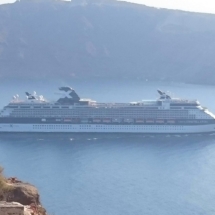


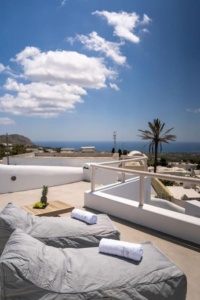
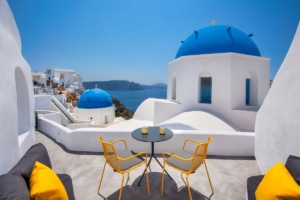
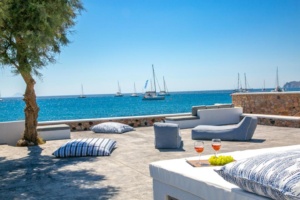
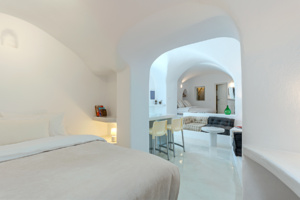
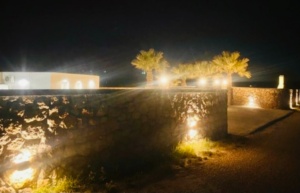
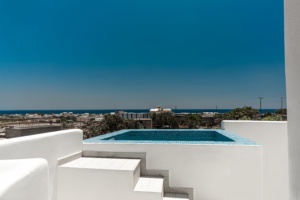
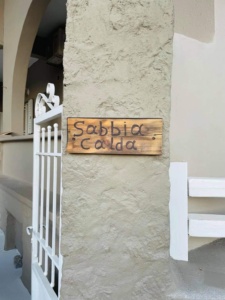
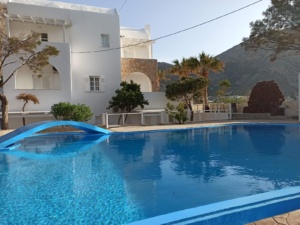


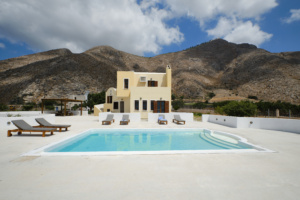

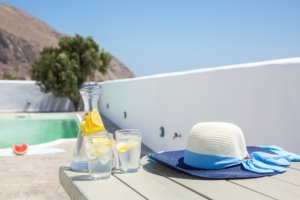
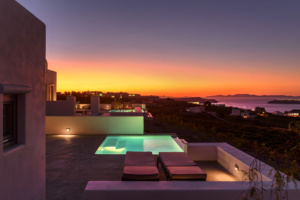
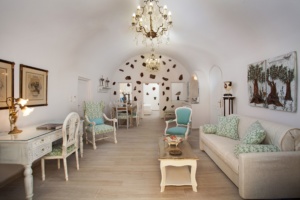
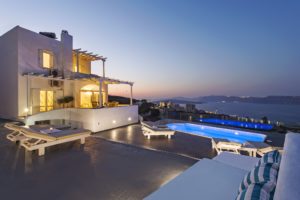


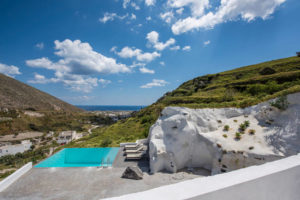
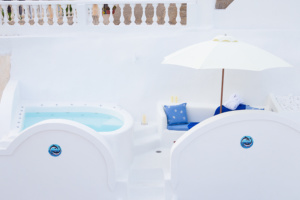

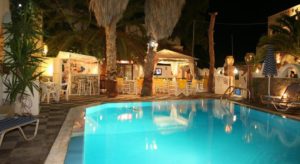
Recent Comments